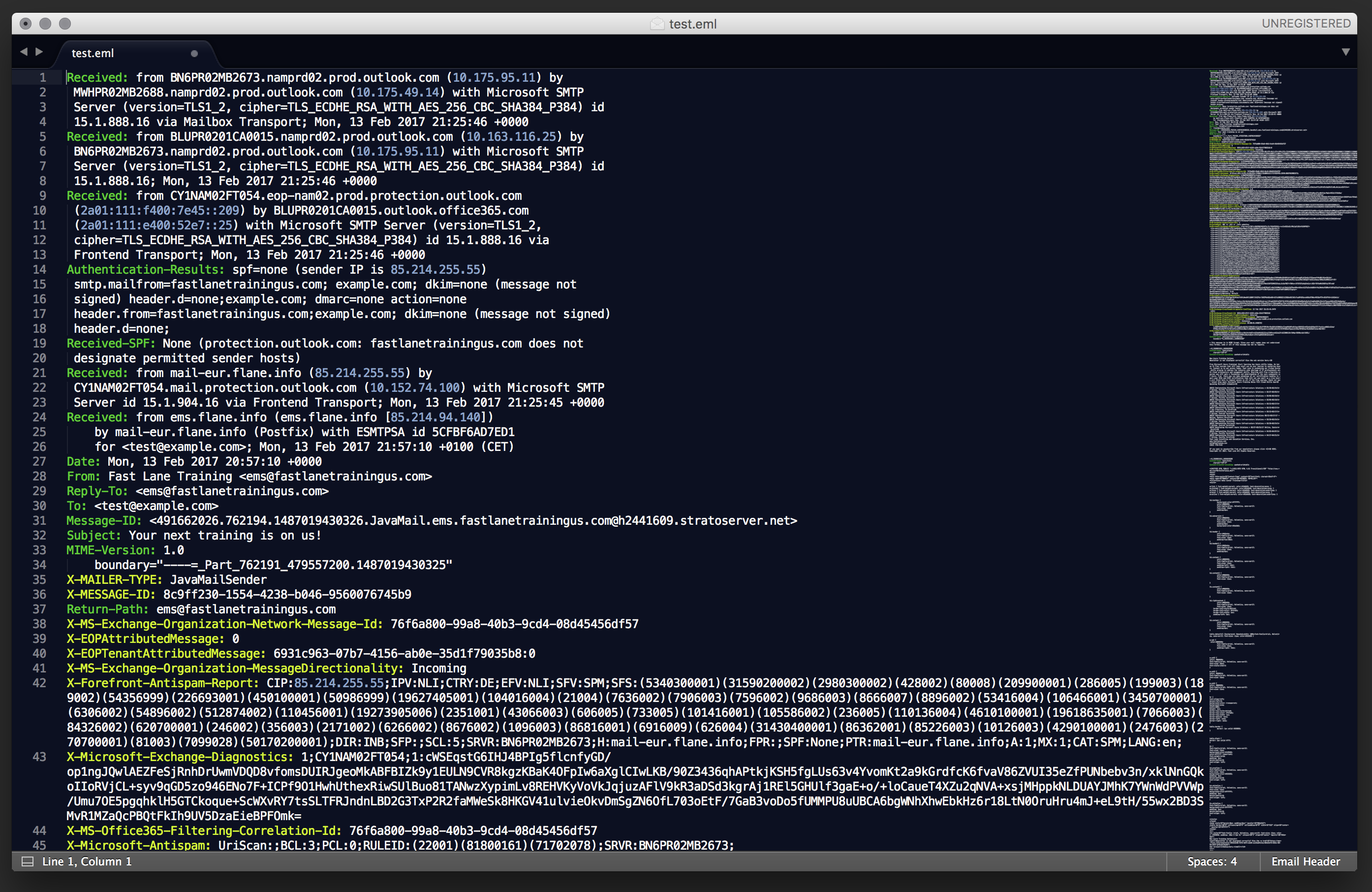Email Header
A Sublime Text 3 syntax highlighting plugin for email message headers.
Labels language syntax, eml, msg, email, e-mail, mail, header, headers, rfc2045, rfc2046, rfc2047, rfc4288, rfc4289, rfc2049
Details
Installs
- Total 8K
- Win 3K
- Mac 1K
- Linux 4K
| Jan 7 | Jan 6 | Jan 5 | Jan 4 | Jan 3 | Jan 2 | Jan 1 | Dec 31 | Dec 30 | Dec 29 | Dec 28 | Dec 27 | Dec 26 | Dec 25 | Dec 24 | Dec 23 | Dec 22 | Dec 21 | Dec 20 | Dec 19 | Dec 18 | Dec 17 | Dec 16 | Dec 15 | Dec 14 | Dec 13 | Dec 12 | Dec 11 | Dec 10 | Dec 9 | Dec 8 | Dec 7 | Dec 6 | Dec 5 | Dec 4 | Dec 3 | Dec 2 | Dec 1 | Nov 30 | Nov 29 | Nov 28 | Nov 27 | Nov 26 | Nov 25 | Nov 24 | Nov 23 | |
|---|---|---|---|---|---|---|---|---|---|---|---|---|---|---|---|---|---|---|---|---|---|---|---|---|---|---|---|---|---|---|---|---|---|---|---|---|---|---|---|---|---|---|---|---|---|---|
| Windows | 2 | 1 | 0 | 1 | 0 | 1 | 2 | 1 | 0 | 0 | 0 | 1 | 0 | 1 | 1 | 1 | 2 | 0 | 4 | 1 | 1 | 3 | 0 | 2 | 0 | 0 | 1 | 0 | 6 | 3 | 1 | 0 | 1 | 1 | 3 | 3 | 2 | 1 | 0 | 1 | 0 | 5 | 2 | 0 | 0 | 1 |
| Mac | 0 | 0 | 0 | 0 | 0 | 0 | 0 | 0 | 0 | 0 | 0 | 0 | 0 | 1 | 0 | 1 | 0 | 0 | 0 | 0 | 0 | 0 | 1 | 0 | 0 | 1 | 0 | 1 | 0 | 1 | 0 | 0 | 0 | 1 | 0 | 1 | 0 | 0 | 0 | 0 | 0 | 0 | 0 | 0 | 0 | 0 |
| Linux | 8 | 8 | 5 | 8 | 8 | 4 | 2 | 4 | 10 | 4 | 6 | 5 | 2 | 8 | 11 | 11 | 8 | 7 | 2 | 4 | 8 | 8 | 9 | 8 | 7 | 2 | 9 | 14 | 6 | 12 | 8 | 9 | 6 | 15 | 5 | 7 | 6 | 8 | 2 | 6 | 10 | 5 | 8 | 10 | 2 | 9 |
Readme
- Source
- raw.githubusercontent.com
EmailHeader
This plugin will parse .eml or .msg files for email message headers, including x-headers, and will also color IPv4 and IPv6 addresses for ease of readability. Note: requires Sublime Text build 3092 or higher.

Manual Installation
Open Sublime Text 3 and navigate to Preferences > Browse Packages… This should open the location on the file system under which Sublime Text 3 stores its packages.
Drop the “EmailHeader.sublime-syntax” within the “User” directory and the software should automatically add an “Email Header” syntax option in the lower right-hand corner. Any files with the .eml and .msg extensions will have this syntax definition automatically applied.
